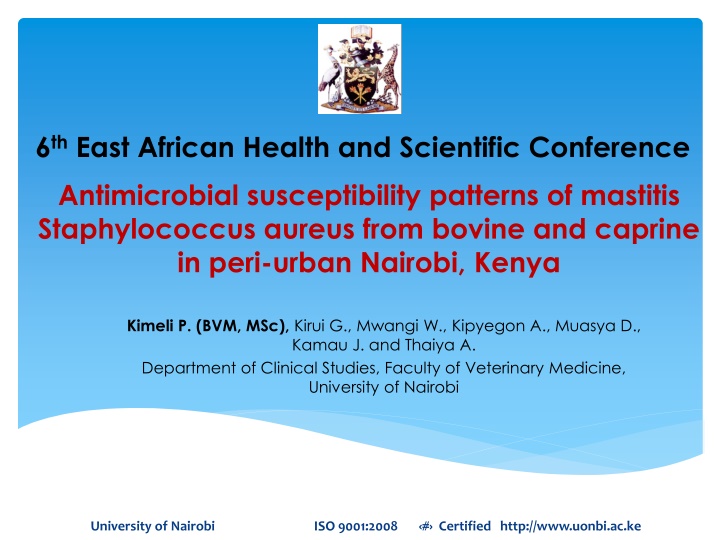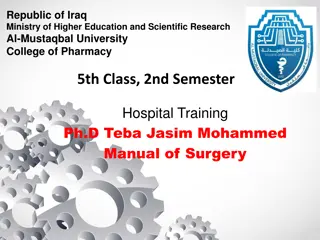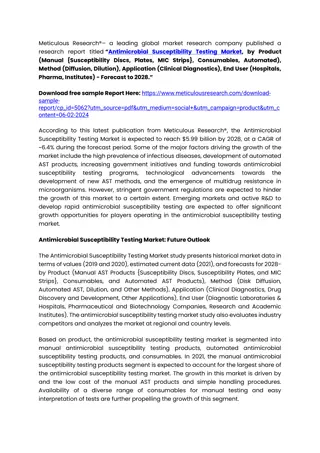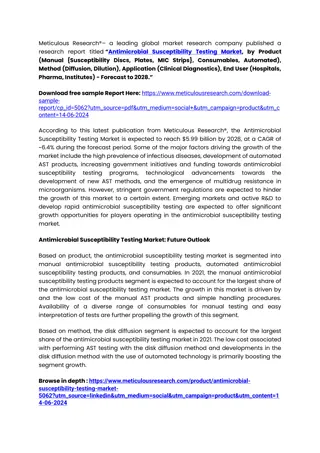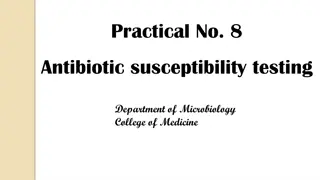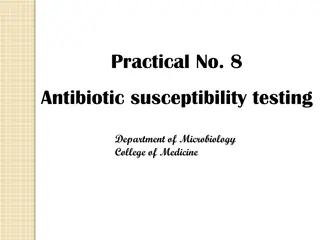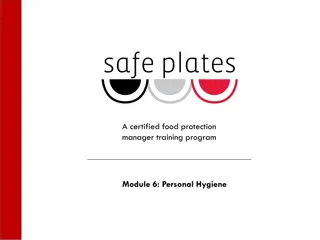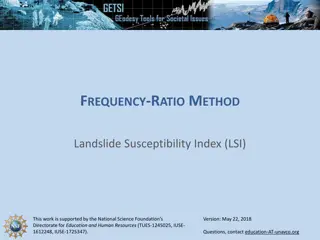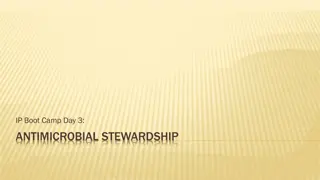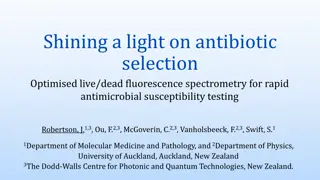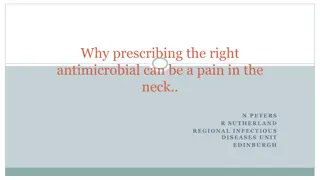Antimicrobial Susceptibility Patterns of Mastitis Staphylococcus aureus in Nairobi
Mastitis, a significant issue in dairy farming, is often caused by Staphylococcus aureus. This study evaluates antimicrobial resistance trends in S. aureus isolated from bovine and caprine with mastitis in Nairobi from 2004 to 2014. A retrospective review was conducted to determine antimicrobial susceptibility patterns using milk samples from peri-urban areas. The effectiveness of nine common antimicrobial drugs was assessed, and results were analyzed to understand the distribution and susceptibility of bacterial isolates.
Download Presentation

Please find below an Image/Link to download the presentation.
The content on the website is provided AS IS for your information and personal use only. It may not be sold, licensed, or shared on other websites without obtaining consent from the author.If you encounter any issues during the download, it is possible that the publisher has removed the file from their server.
You are allowed to download the files provided on this website for personal or commercial use, subject to the condition that they are used lawfully. All files are the property of their respective owners.
The content on the website is provided AS IS for your information and personal use only. It may not be sold, licensed, or shared on other websites without obtaining consent from the author.
E N D
Presentation Transcript
6th East African Health and Scientific Conference Antimicrobial susceptibility patterns of mastitis Staphylococcus aureus from bovine and caprine in peri-urban Nairobi, Kenya Kimeli P. (BVM, MSc), Kirui G., Mwangi W., Kipyegon A., Muasya D., Kamau J. and Thaiya A. Department of Clinical Studies, Faculty of Veterinary Medicine, University of Nairobi University of Nairobi ISO 9001:2008 # Certified http://www.uonbi.ac.ke
Introduction Mastitis in farm animals is a major cause of economic losses in the dairy sector (Voek et al, 2013; Gitau et all, 2014) Staphylococcus aureus represents the most common and contagious etiologic agent (Shana et al, 2009). S. aureus is also a common cause of invasive and life- threatening infections in humans (Daka et al, 2012; Joshi et al, 2014). Antimicrobial agents are the main therapeutic tools for treatment and control of mastitis (Daka et a, 2012). The main reasons for low efficacy in the treatment of staphylococcal infections is antimicrobial resistance (Lundberg et al, 2014). University of Nairobi ISO 9001:2008 # Certified http://www.uonbi.ac.ke
The expansion of resistance both in human and animal bacterial pathogens has been attributed to the widespread remedial use of antimicrobials (Daka et al, 2012). The aim of this retrospective study was to evaluate the antimicrobial resistance trend in resistance of S. aureus strains isolated from bovine and caprine with clinical and sub-clinical mastitis from the year 2004 to 2014. University of Nairobi ISO 9001:2008 # Certified http://www.uonbi.ac.ke
Materials & Methods A retrospective study was carried at the Bacteriology Laboratory, CSD, UoN, to determine the antimicrobial susceptibility patterns to S. aureus isolates from milk samples received from the peri-urban areas of Nairobi between the years 2004 and 2014. The bacterial isolates were tested for sensitivity to nine antimicrobial drugs commonly used by ambulatory clinic using Agar Disk Diffusion Technique. University of Nairobi ISO 9001:2008 # Certified http://www.uonbi.ac.ke
Effectiveness of a drug was determined by measuring the diameter of the zone of inhibition around the disc A zone diameter of: 0-8mm was considered resistant 9-15mm mildly susceptible 16-22mm moderately susceptible 23mm susceptible Descriptive statistics were computed on Microsoft Office Excel 2007 to establish the frequencies and percentages of species annual distribution & antimicrobial susceptibility University of Nairobi ISO 9001:2008 # Certified http://www.uonbi.ac.ke
Results & Discussions A total of 582 isolates were studied from bacterial cultures obtained from the both bovine (97%)and caprine (3%) milk samples received at the Bacteriology Laboratory Overall, 1% of the S. aureus isolates were susceptible to all of the antimicrobial agents tested While 4% of all isolates were resistant to all of the antimicrobial agents tested University of Nairobi ISO 9001:2008 # Certified http://www.uonbi.ac.ke
No. of Isolates per year Year 2004 2005 2006 2007 2008 2009 2010 2011 2012 2013 2014 Grand Total No. of Isolates 38 25 28 32 25 173 86 36 31 86 22 582 % 6.53% 4.30% 4.81% 5.50% 4.30% 29.73% 14.78% 6.19% 5.33% 14.78% 3.78% 100.00% University of Nairobi ISO 9001:2008 7 Certified http://www.uonbi.ac.ke
The susceptibility (23mm susceptible) of the antibiotics in decreasing order against Staphylococcus aureus was found to be; Cefaclor (57%), Ampiclox (54%), Ampicillin (20%), Gentamicin (2%), Norfloxacin (2%), Tetracycline (2%), Kanamycin (1%), Cotrimoxazole (1%) Streptomycin (1%). Above 50% Below 50% University of Nairobi ISO 9001:2008 # Certified http://www.uonbi.ac.ke
Cefaclor 60.00% 50.00% Mildly susceptible Moderately Susceptible 40.00% Resistant 30.00% Susceptible 20.00% 10.00% 0.00% 2004 2005 2006 2007 2008 2009 2010 2011 2012 2013 2014 Ampiclox 90.00% 80.00% 70.00% Mildly susceptible 60.00% Moderately Susceptible 50.00% Resistant 40.00% Susceptible 30.00% 20.00% 10.00% 0.00% 2004 2005 2006 2007 2008 2009 2010 2011 2012 2013 2014 University of Nairobi ISO 9001:2008 # Certified http://www.uonbi.ac.ke
Resistance (0-8mm resistant) to antibiotics in decreasing trend was: Cotrimoxazole(81%), Ampicillin (46%), Tetracycline (23%0), Streptomycin (23%), Ampiclox (20%), Cefaclor (20%), Kanamycin (17%), Gentamycin (5%) and Norfloxacin (4%). University of Nairobi ISO 9001:2008 # Certified http://www.uonbi.ac.ke
Cotrimazole 120.00% Mildly Susceptible 100.00% 80.00% Moderately Susceptible 60.00% 40.00% Resistant 20.00% 0.00% Susceptible 2004 2005 2006 2007 2008 2009 2010 2011 2012 2013 2014 Mildly Susceptible Ampicillin 70.00% 60.00% Moderately Susceptible 50.00% Resistant 40.00% 30.00% Susceptible 20.00% 10.00% 0.00% 2004 2005 2006 2007 2008 2009 2010 2011 2012 2013 2014 University of Nairobi ISO 9001:2008 # Certified http://www.uonbi.ac.ke
Important to Note -Resistant strains >> on gradual rise. - Susceptible strains >> on decreasing trend. - The dynamics noted in 2013 (Increasing susceptible strains) may be attributed to global campaign towards responsible use of antibiotic. - Most of the isolates were either mildly or moderately susceptible to various antimicrobials - This is suggestive of reducing susceptible to antimicrobials and increase in bacterial resistance. University of Nairobi ISO 9001:2008 # Certified http://www.uonbi.ac.ke
Conclusion The current study has demonstrated the existence of alarming levels of resistance of S. aureus to commonly used antimicrobials. Given this antimicrobial drug resistance and zoonotic nature of the S. aureus, a similar picture may occur in humans. Frequent surveillance for antimicrobial resistance of S. aureus isolated from dairy animals with mastitis is strongly recommended as an important component of prudent antimicrobial use practices. University of Nairobi ISO 9001:2008 # Certified http://www.uonbi.ac.ke
Acknowledgement I wish to acknowledge the department of Clinical Studies, University of Nairobi, who gave us the permission to access this data University of Nairobi ISO 9001:2008 # Certified http://www.uonbi.ac.ke
